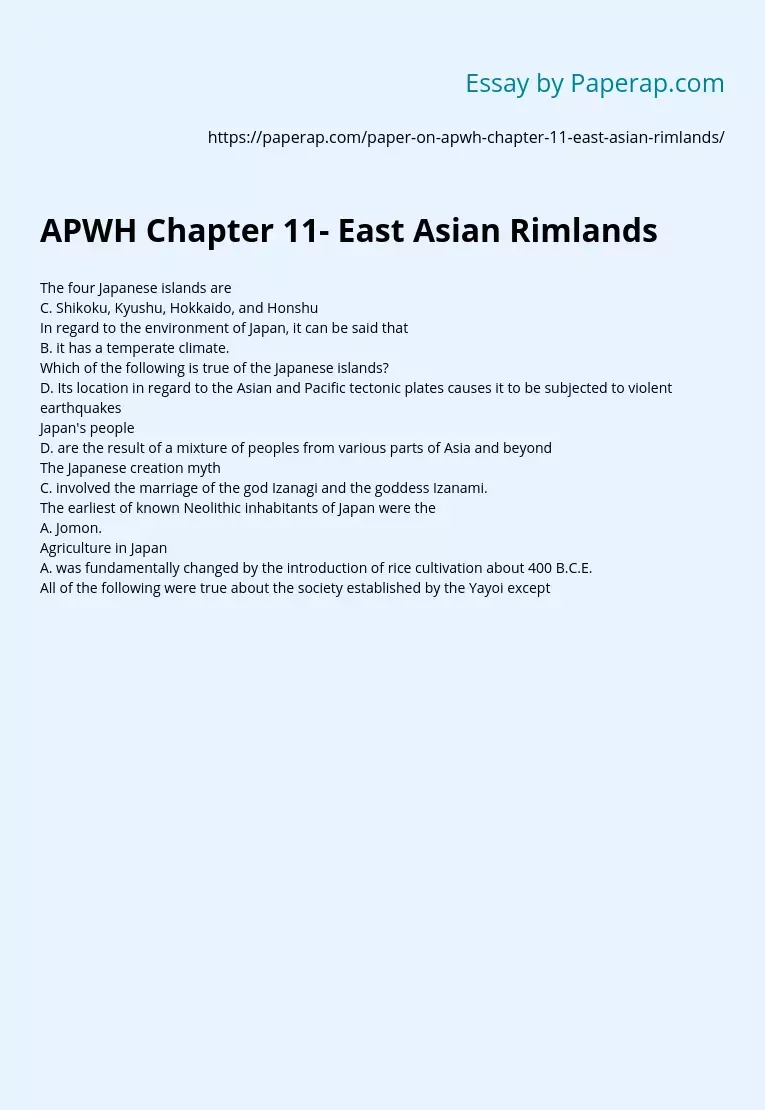Essay,
Pages 4 (930 words)
Views
210
The four Japanese islands are
C. Shikoku, Kyushu, Hokkaido, and Honshu
In regard to the environment of Japan, it can be said that
B. it has a temperate climate.
Which of the following is true of the Japanese islands?
D. Its location in regard to the Asian and Pacific tectonic plates causes it to be subjected to violent earthquakes
Japan’s people
D. are the result of a mixture of peoples from various parts of Asia and beyond
The Japanese creation myth
C. involved the marriage of the god Izanagi and the goddess Izanami.
The earliest of known Neolithic inhabitants of Japan were the
A. Jomon.
Agriculture in Japan
A. was fundamentally changed by the introduction of rice cultivation about 400 B.C.E.
All of the following were true about the society established by the Yayoi except
A. the foundation of the society was its basic unit, called the uji which was then subdivided into into tribes.
In reaction to the Tang infiltration into the Korean Peninsula
C. Shotoku Taishi made contacts with Tang rulers for the purpose of adopting Chinese governing methods.
The so called seventeen article constitution involved
C. Shotoku Taishis program to strengthen and centralize Japanese government by establishing a supreme and divine ruler who employed a Chinese-type civil service system.
Shotuku Taishi
C. used Chinese political procedures to strengthen Japanese unity to resist Chinese power.
After the death of Shotoku Taishi,
C. the unequal availability of the civil service examinations enabled the aristocracy to dominate the government.
The shoen system
D. referred to control of tax-exempt lands by powerful aristocratic families
The new class of Japanese military officials and retainers whose purpose was to protect their patrons and their property was the
C. samurai.
Known as the way of the warrior, the strict code of the Japanese retainer was called
B. Bushido.
The shogunate system was established by
B. Minamoto Yoritomo
The essence of the shogunate system was that
B. governmental power became centralized and placed in the hands of the shogun, while the emperor ruled in name only.
The Japanese word that refers to the divine wind of the massive typhoon that destroyed the invading Mongol fleet of Khunilai Khan is
D. kamikaze.
The samurai
B. were like medieval European knights, except that the samurai were equipped with bows and arrows rather than lances an shields.
Under the Ashikaga shogunate,
C. daimyo reliance on samurai protection increased.
The Onin War
E. effectively destroyed the power of the shogunate in the 1470’s
Unlike the situation in China, the struggle between central authority and local aristocracies endured into early modern times in Japan because
B. china established a merit-based civil service examination system, while the Japanese maintained it as an elitist process, thus enhancing the power of the local aristocracy at the expense of the emperor.
Trade in Japan
B. had reached a stage where trimonthly markets were held in larger towns during the Kamakura period.
The paper, iron-casting, and percelain industries in China enabled Japanese trade and manufacturing to increase during the period of the
B. Kamakura
The genin were
C. landless laborers who could be bought and sold by the owners of the land
The class of hereditary slaves who performed degrading occupation sin Japan was the
C. eta
In medieval Japan, women
C. had varying status, enjoying relative equality as well as suffering discrimination in others.
Facets of the Japanese state religion included all except the
E. existence of a complicated and formal theological system
Shinto
B. involves the performance of ritual acts, usually performed at a shrine.
The Buddhist sect that taught that devotion alone could lead to enlightenment and release was the
B. Pure Land Sect
The Japanese Zen term for enlightenment is
B. satori.
One specific characteristics of Japanese culture is
C. its ability to blend native influences with concepts acquired from other cultures.
Which of the following is an accurate characterization of the relationship between the Chinese and Japanese written languages?
D. using Chinese characters as phonetic symbols, Japan created a workable “hybrid” system
Which of the following is a valid observation about Japanese poetry?
C. Knowledge and use of poetry was considered a mark of upper-class behavior
Japanese poetry
C. expressed themes in simple forms designed to create a general mood.
The Japanese “linked verse” is known as
B. haiku
Japanese haiku
A. often focused on images from nature.
The Tale of Genji
A. was written by Murasaki Shikibu, a female diarist and court author.
No
E. all of the above.
Which of the following cultures had a painting style that presented the frail beauty of nature through the use of a smaller scale?
C. Japanese
Literally meaning “pot scenery,” the Japanese word for miniature plant display is
B. bonsai.
In addition to their beautiful gardens, another Japanese cultural contribution that represents a fusion of Zen and aesthetics is the
C. tea ceremony.
Japanese peasants were
C. in the case of the eta, similar in social status to Indian untouchables or pariahs.
Korea
A. was more influenced by Chinese ideas and practices than any other East Asian society
Korea and Vietnam
C. adopted Confucian institutions in order to facilitate political centralization
The Three Kingdoms of early Korea were
B. Paekche, Silla, and Koguryo
In Vietnam
C. most males could take the civil service examination if they wanted.
In spite of the impact of Chinese influence,
A. Vietnam developed chu nom, which was a writing system for spoken Vietnamese.
The societies of Vietnam and Korea
D. never adopted the ideas and practices of Shinto.
The Mongols
E. a, b, and c
APWH Chapter 11- East Asian Rimlands. (2017, Dec 13). Retrieved from https://paperap.com/paper-on-apwh-chapter-11-east-asian-rimlands/

